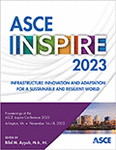Automated Thermal Zoning and Multi-Objective Optimization of Embodied and Operational Energy and Carbon Emissions of Buildings
Publication: ASCE Inspire 2023
ABSTRACT
A large portion of global energy consumption and carbon emissions stems from the building operation and initial construction. Due to the operational-embodied energy and carbon emissions-energy trade-offs, and limited comprehensive software, developing an energy-efficient and environment-friendly building design necessitates a thorough yet automated and integrated framework. This study proposes a multi-phase and multi-objective genetic-based framework. The framework involves an add-in tool that automatically creates the multi-zone energy model of the building and then couples EnergyPlus to the embodied energy and carbon databases through a Python script to optimize the building in terms of energy and carbon emissions. The proposed framework is applied to a medium office building that is optimized in two phases under the College Station weather conditions. In the first phase of optimization, the operational and embodied energy is reduced by 33.26% and 50.93% from the baseline model, respectively. The second phase optimization decreased operational energy, embodied energy, operational carbon, and embodied carbon by 31.54%, 52.5%, 32.89%, and 51% from the baseline, respectively.
Get full access to this article
View all available purchase options and get full access to this chapter.
REFERENCES
Bastos Porsani, G., Del Valle de Lersundi, K., Sánchez-Ostiz Gutiérrez, A., and Fernández Bandera, C. (2021). Interoperability between building information modelling (BIM) and building energy model (BEM). Applied Sciences, 11(5), 2167.
Chau, C. K., Leung, T., and Ng, W. (2015). A review on life cycle assessment, life cycle energy assessment and life cycle carbon emissions assessment on buildings. Applied Energy, 143, 395–413.
Ciardiello, A., Rosso, F., Dell’Olmo, J., Ciancio, V., Ferrero, M., and Salata, F. (2020). Multi-objective approach to the optimization of shape and envelope in building energy design. Applied Energy, 280, 115984.
Dixit, M. K. (2019). Life cycle recurrent embodied energy calculation of buildings: A review. Journal of Cleaner Production, 209, 731–754.
Dixit, M. K., Culp, C. H., Fernandez-Solis, J. L., and Lavy, S. (2016). Reducing carbon footprint of facilities using a facility management approach. Facilities.
Dogan, T., and Reinhart, C. (2013). Automated conversion of architectural massing models into thermal ‘shoebox’models. Proceedings of BS2013.
Dogan, T., Reinhart, C., and Michalatos, P. (2016). Autozoner: an algorithm for automatic thermal zoning of buildings with unknown interior space definitions. Journal of Building Performance Simulation, 9(2), 176–189.
EnergyPlus version 9.3.0 [Computer software]. (2020). Retrieved from https://energyplus.net/.
Jafari, A., and Valentin, V. (2018). Selection of optimization objectives for decision-making in building energy retrofits. Building and Environment, 130, 94–103.
Jones, N. L., McCrone, C. J., Walter, B. J., Pratt, K. B., and Greenberg, D. P. (2013). Automated translation and thermal zoning of digital building models for energy analysis.
Kheiri, F. (2018). A review on optimization methods applied in energy-efficient building geometry and envelope design. Renewable and Sustainable Energy Reviews, 92, 897–920.
Liang, Y., Pan, Y., Yuan, X., Yang, Y., Fu, L., Li, J., Sun, T., Huang, Z., and Kosonen, R. (2022). Assessment of operational carbon emission reduction of energy conservation measures for commercial buildings: Model development. Energy and Buildings, 112189.
Lim, T., Yim, W.-S., and Kim, D.-D. (2022). Analysis of the thermal and cooling energy performance of the perimeter zones in an office building. Buildings, 12(2), 141.
Menberg, K., Heo, Y., and Choudhary, R. (2016). Sensitivity analysis methods for building energy models: Comparing computational costs and extractable information. Energy and Buildings, 133, 433–445.
Mukkavaara, J., and Shadram, F. (2021). An integrated optimization and sensitivity analysis approach to support the life cycle energy trade-off in building design. Energy and Buildings, 253, 111529.
Nguyen, A.-T., Reiter, S., and Rigo, P. (2014). A review on simulation-based optimization methods applied to building performance analysis. Applied Energy, 113, 1043–1058.
SketchUp Pro[Computer software]. (2022). Retrieved from https://www.sketchup.com/.
Sanhudo, L., Ramos, N. M., Martins, J. P., Almeida, R. M., Barreira, E., Simões, M. L., and Cardoso, V. (2018). Building information modeling for energy retrofitting–A review. Renewable and Sustainable Energy Reviews, 89, 249–260.
Shin, M., and Haberl, J. S. (2019). Thermal zoning for building HVAC design and energy simulation: A literature review. Energy and Buildings, 203, 109429.
Shin, M., and Haberl, J. S. (2022). A procedure for automating thermal zoning for building energy simulation. Journal of Building Engineering, 46, 103780.
Tian, Z., Chen, W., Tang, P., Wang, J., and Shi, X. (2015). Building energy optimization tools and their applicability in architectural conceptual design stage. Energy Procedia, 78, 2572–2577.
Venkatraj, V., and Dixit, M. (2021). Life cycle embodied energy analysis of higher education buildings: A comparison between different LCI methodologies. Renewable and Sustainable Energy Reviews, 144, 110957.
Venkatraj, V., Dixit, M. K., Yan, W., and Lavy, S. (2020). Evaluating the impact of operating energy reduction measures on embodied energy. Energy and Buildings, 226, 110340.
Xu, Y. (2022). Building performance optimization for university dormitory through integration of digital gene map into multi-objective genetic algorithm. Applied Energy, 307, 118211.
Zhuang, D., Zhang, X., Lu, Y., Wang, C., Jin, X., Zhou, X., and Shi, X. (2021). A performance data integrated BIM framework for building life-cycle energy efficiency and environmental optimization design. Automation in Construction, 127, 103712.
Information & Authors
Information
Published In
History
Published online: Nov 14, 2023
ASCE Technical Topics:
- Air pollution
- Building design
- Buildings
- Carbon fibers
- Design (by type)
- Ecosystems
- Emissions
- Energy consumption
- Energy engineering
- Energy sources (by type)
- Engineering fundamentals
- Engineering materials (by type)
- Environmental engineering
- Fibers
- Materials engineering
- Models (by type)
- Optimization models
- Pollution
- Renewable energy
- Structural engineering
- Structures (by type)
- Thermal power
- Zoning
Authors
Metrics & Citations
Metrics
Citations
Download citation
If you have the appropriate software installed, you can download article citation data to the citation manager of your choice. Simply select your manager software from the list below and click Download.
